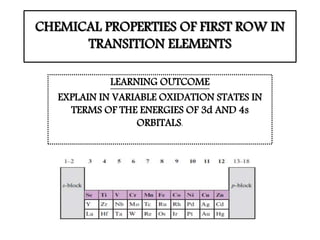
Inorganic Chemistry : Transition Elements (Chemical properties of first row in transition elements)
- 1. CHEMICAL PROPERTIES OF FIRST ROW IN TRANSITION ELEMENTS LEARNING OUTCOME EXPLAIN IN VARIABLE OXIDATION STATES IN TERMS OF THE ENERGIES OF 3d AND 4s ORBITALS.
- 2. OCCURANCE OF VARIABLE OXIDATION STATES • Most obvious characteristics chemical properties of the transition metals is the occurrence of variable oxidation states. • All transition metals from titanium to copper exhibit two or more oxidation states in their compounds. The small energy difference between the 3d and 4s subshells enable the electrons from the 4s as well as a variable number of electrons from the 3d subshell to be involved in bonding. The wide range of oxidation states shown by the transition elements . More to known as oxidation states of the first d-block series .
- 3. • From scandium to manganese , the maximum oxidation states increases , corresponding to the involvement of all the electrons in the 3d and 4s orbitals. That is , form +3 in scandium to +7 in manganese. • Conversely , the maximum oxidation states decreases from manganese to zinc . This is because the pairing of d electrons occurs after manganese based on Hund’s rule which in turn decreases the number of available unpaired electrons. Hence, the number of oxidation states decreases from +7 in manganese to +2 in zinc. .
- 5. OXO IONS OF TRANSITION ELEMENTS 1) Transition elements in lower oxidation states (+1,+2,+3) exist as simple ions. 2) However , transition elements do not form simple ions in higher oxidation states ( +4 to +7 ) . 3) Compounds or ions containing transition elements in higher oxidation states are usually bonded covalently to electronegative elements like oxygen or fluorine to form Oxo ions .
- 6. 4) Transition metal ions in higher oxidation states have covalent characteristics and tend to make good oxidising agents. The purple Manganate (VII) ion and the orang Dichromate (VI) ion are familiar oxidising agents. Their oxidising power is indicated by the highly positive standrad electrode potentials. 5) There is a tendency for intermediate oxidation states to disproportionate. 6) Stability of a particular oxidation state may be affected by the pH of a solutions. Eg : 3MnO4²- + 4H+ 2MnO4- + MnO2 + 2H2O
- 7. OXIDES OF TRANSITION ELEMENTS • Most transition metals react with oxygen to form oxides. The oxides are nearly all insoluble in water with appreciable covalent character. The oxides are either black or coloured . ( RUJUK BUKU PAGE 185 Table 13.6 ) • Transition elements with low oxidation states (+2 and +3) usually form basic electrovalent oxides, whereas those with higher oxidation states usually form acidic covalent oxides . ( RUJUK BUKU PAGE 185 )
- 8. +2 and +3 OXIDATION STATES • The most common oxidation states are +2 and +3. All the transition elements from titanium to copper exhibits both these two oxidation states in their compounds. • The relative stability of +2 oxidation state increases but the stability of +3 state decreases across the period. • The relative stabilities of the +2 and +3 oxidation states in aqueous solutions can be predicted based on the standard electrode potentials. • A graphical method may be used to compare the relative stabilities of +2 an +3 oxidation solutions. The E° values for the M²+/M and M³+/M²+ systems are represented in graph ( RUJUK BUKU )
- 9. • The negative standard electrode potentials M³+/M²+ for titanium, vanadium and chromium indicate that the higher oxidation state +3 is more stable for Ti , V and Cr . • The positive standard electrode potential of Mn3+/Mn2+ and Co3+/Co2+ indicates that Mn²+ and Co²+ are the stables states in aqueous solution. • In the absence of oxygen , Fe²+ ion is the stable state in aqueous solution. However, in the presence of oxygen in air, the Fe²+ ion is unstable and will be further oxidised to Fe³+ ion. • The +2 ions starts as strong reducing agents and become more stable across the period . Whereas the +3 ions start stable and become more oxidising across the period.
